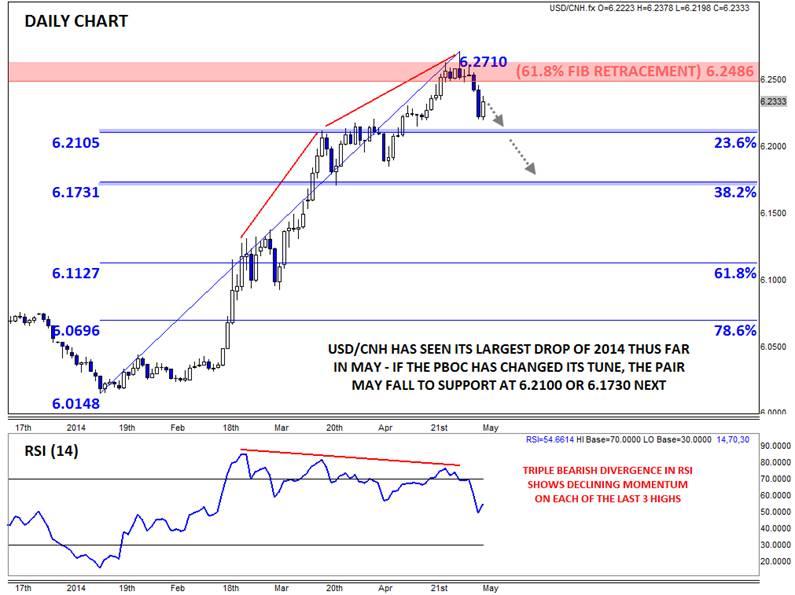![]()
One of the most consistent themes throughout the first four months of 2014 has been the ongoing weakness of the Chinese yuan. After nearly dropping all the way to 6.00 in early January, the USD/CNH (off-shore Chinese yuan) rallied all the way up to an 18-month high at 6.27 as of last week. As traders have turned their calendar pages over to May, however, that trend has shown nascent signs of reversing, with the USD/CNH falling over 500 pips thus far this month, the largest decline since the January low.
Any time there is a meaningful movement in the yuan, the base assumption is that Chinese government is behind it. In fact, a former member of the PBOC monetary policy committee recently stated, “I can say with near certainty that the renminbi's depreciation in the first quarter was mainly the result of the central bank's intervention in the foreign exchange market,” implying that the most recent rally in the yuan (renminbi) may also be attributed to the PBOC. The biggest question traders are asking themselves is “Is the PBOC starting to reverse its course?” and the obvious corollary question is “For how long will it continue?”
Unfortunately, even the first question doesn’t have an obvious answer. It’s possible that the PBOC just wanted to inject the perception of two-way trade into the currency; just as traders had become too one-sided in betting for continued strength at the beginning of the year, the PBOC may believe that pendulum had swung too far in the other direction, toward one-sided expectations of yuan weakness. In addition, some analysts have noted a tendency for the USD/CNH to weaken at the beginning of the month and to strengthen toward the end of the month based on demand from large international corporations.
Of course, the first explanation above would suggest the potential for more weakness in USD/CNH as we move through May, whereas the second potential cause of the USD/CNH may already be played out. Therefore, traders should closely monitor the price action over the next week or so, as continued weakness in the pair would tilt the odds toward a substantial policy shift from the PBOC. Regardless of the reasons, traders expecting the 4-month trend of consistent strength in the USD/CNH to continue into the summer months may be disappointed.
Technical View
As always, the efficacy of technical analysis is relatively limited on currency pairs under “managed float” regimes, like the USD/CNH. That said, there are some ominous indications that suggest caution is warranted for bullish traders. Prominently, the pair has turned lower off the 61.8% Fibonacci retracement of its July 2012 – January 2014 drop near 6.25. The failed breakout above this key resistance level is a potentially strong bearish indication that could foreshadow a larger drop moving forward. Beyond the pure price action, the RSI has also dropped to a 3-month low after showing a triple bearish divergence with price, a normally reliable indicator of a top.
If we do see rates pull back, technical support is possible at the 23.6% Fibonacci retracement of this year’s rally at 6.2100, followed by the 38.2% retracement at 6.1730. Meanwhile, a reversal and break back above 6.25 would suggest that the PBOC may have changed its tune once again and would augur for a shift back to a bullish bias looking ahead.
CFD’s, Options and Forex are leveraged products which can result in losses that exceed your initial deposit. These products may not be suitable for all investors and you should seek independent advice if necessary.
Recommended Content
Editors’ Picks
EUR/USD edges lower toward 1.0700 post-US PCE

EUR/USD stays under modest bearish pressure but manages to hold above 1.0700 in the American session on Friday. The US Dollar (USD) gathers strength against its rivals after the stronger-than-forecast PCE inflation data, not allowing the pair to gain traction.
GBP/USD retreats to 1.2500 on renewed USD strength

GBP/USD lost its traction and turned negative on the day near 1.2500. Following the stronger-than-expected PCE inflation readings from the US, the USD stays resilient and makes it difficult for the pair to gather recovery momentum.
Gold struggles to hold above $2,350 following US inflation

Gold turned south and declined toward $2,340, erasing a large portion of its daily gains, as the USD benefited from PCE inflation data. The benchmark 10-year US yield, however, stays in negative territory and helps XAU/USD limit its losses.
Bitcoin Weekly Forecast: BTC’s next breakout could propel it to $80,000 Premium

Bitcoin’s recent price consolidation could be nearing its end as technical indicators and on-chain metrics suggest a potential upward breakout. However, this move would not be straightforward and could punish impatient investors.
Week ahead – Hawkish risk as Fed and NFP on tap, Eurozone data eyed too

Fed meets on Wednesday as US inflation stays elevated. Will Friday’s jobs report bring relief or more angst for the markets? Eurozone flash GDP and CPI numbers in focus for the Euro.
